How to Harvest and Store Garden Carrots
Growing carrots requires patience and tender loving care, especially in our Red River gumbo soil (heavy clay). The seeds can take weeks to germinate and once they sprout they need consistent watering. But it’s all worth it when you get to harvest and freeze or dehydrate these beauties.
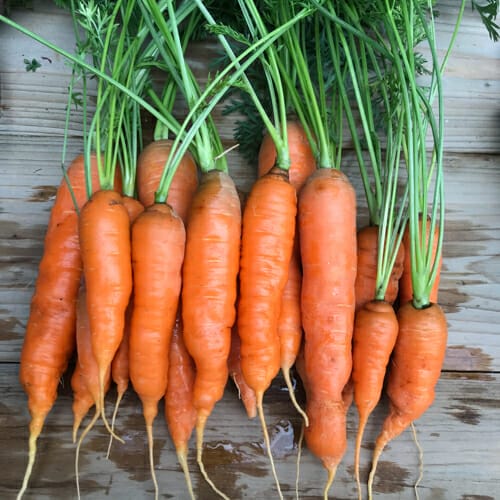
Read more: How to Blanch & Freeze Carrots, Dehydrate Carrots, Carrot Cake, Roasted Carrots & Carrot Granola.
Carrots can be harvested when they’re little or big; in fact, they’ll keep in the ground long after the frost or first snowfall has occurred. However, when it comes to carrots, bigger is not necessarily better. If the temperature continues to be warm, carrots will continue to grow. The inner core (you know, that tough channel that runs in the center of a carrot) also gets bigger and the outer skin may start to become bitter. Carrots that stay in the ground may also split open or become prey to moles, rabbits or other garden pests. In the end, leaving them until the very end of the gardening season may not be the best idea.
For the sweetest flavour, harvest carrots when they’re about 3/4 inch or 2 cm wide at the top.
How to Harvest Carrots
How to Harvest Carrots
Equipment
- 1 Garden Fork
Ingredients
- 1 row of Carrots
Instructions
- For the sweetest flavor, harvest carrots when they’re about 3/4 inch or 2 cm wide at the top.
In sandy, very light soil
- Grab onto the carrot greens, just at the top of the carrot and simply pull it out.
In heavy clay soil
- You definitely cannot simply pull them out of the ground- the carrots will snap.
- The best tool for the job is a garden fork that allows you to dig out the carrots. But be careful not to hit or scar the carrots with the tines of the forks.
- Place the fork about 6 inches away from the carrots and use it to loosen the soil all around the carrots. When the soil is loose, you should be able to pull out the carrots.
Video
Notes
How to Harvest Carrots
In sandy soil you can walk up to a carrot, grab onto the greens just at the top of the carrot and simply pull it out. That’s only possible if you have very light soil.
In our heavy clay soil, you have to hire a backhoe and dig around the carrot before it is released from the clutches of the earth. How they manage to grow in this soil is beyond me and a true testament to the power of Mother Nature.
Okay, a backhoe may be overkill, but you definitely cannot simply pull them out of the ground- the carrots will snap. The best tool for the job is a garden fork that allows you to dig out the carrots. But be careful not to hit or scar the carrots with the tines of the forks. Place the fork about 6 inches away from the carrots and use it to loosen the soil all around the carrots. When the soil is loose, you should be able to pull out the carrots.
Once you have all those lovely carrots out of the ground, remove as much dirt as you can, but DO NOT wash them! Only wash them when you’re ready to use them so you don’t add moisture to the carrots. Moisture leads to mold and rot – it must be avoided at all costs when storing carrots for long periods.
How to Store Garden Carrots
- Remove all greens from carrots – the greens will draw moisture out of the carrots causing them to become limp and they’ll add moisture to the surrounding space which could lead to mold.
- Do not wash the carrots – just brush off the dirt.
- Sort through the carrots and use any that are cut or damaged in any way.
- Allow carrots to air dry in the sun for half a day to ensure there is no surface moisture on them.
- Store dry carrots in a perforated plastic bag in the fridge or cool, dry storage area (4-8°C) or (39-46°F).
- Check the carrots periodically to ensure there is no moisture in the bag – use the carrots right away if moisture is developing. Or pat them dry and add an absorbent towel to the bag.
- Store away from apples, pears, potatoes and other fruits and vegetables that produce ethylene gas which will cause carrots to become bitter.
OR
Bury unwashed carrots in a large container of damp sand or sawdust and keep them in a cool (just above freezing), dark place for months. We used to do this on the farm where we had a nice cool, dark cellar. Our city house is well insulated and much too warm to store carrots.
How to Store Grocery Store Carrots
The general rules for storing carrots are:
- wash only when ready to use them
- do not store with apples, pears, potatoes or other produce that emit ethylene gas
- keep in a plastic bag in the crisper of your refrigerator (ideally the bag that the carrots came in)
Store bought carrots with the green tops are a good indicator of how fresh the carrots are. Crisp, rich coloured tops are a good sign of fresh carrots. However, once you get them home, remove the greens and store the carrots as indicated above.
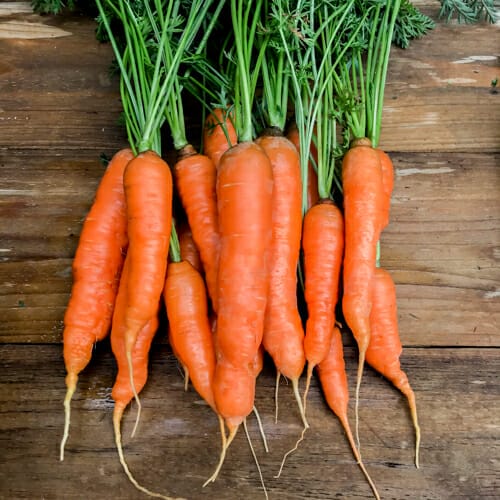
How to Store Washed, Cut and Ready to Eat Carrots
- Want to store washed, cut and ready to eat carrots? Just follow the same advice as above.
- Keep peeled, baby-cut carrots in a perforated bag in the crisper of the fridge. If they are getting dry, add a damp towel to the bag, if they are getting soggy, pat them dry and add a dry towel to the bag.
- Having carrot sticks ready for a quick snack is a great idea, here’s a post providing more information on storing fresh cut veggies.

If you have more carrots than fridge or cellar space, try freezing or dehydrating your carrots.
Getty Stewart is an engaging speaker and writer providing tasty recipes, time-saving tips, and helpful kitchen ideas to make home cooking easy and enjoyable. She is a Professional Home Economist, author of Manitoba’s best-selling Prairie Fruit Cookbook, Founder of Fruit Share, mom and veggie gardener.


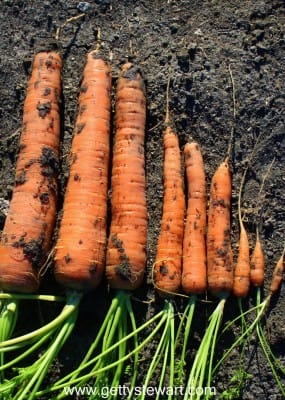

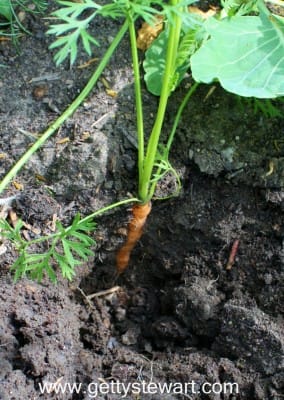
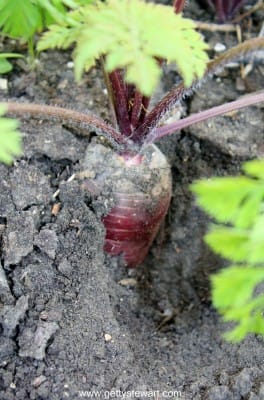
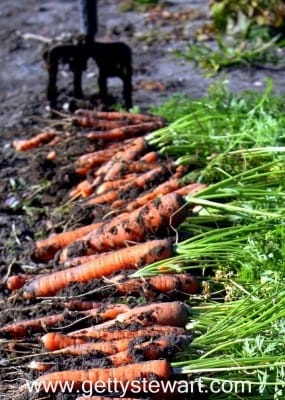
Why are fork tines dangerous
Hi Charles,
Sorry if I was being cryptic! Fork tines are only dangerous to the carrots that might accidentally get stabbed by the tines if you dig too close to the carrots. Any carrot that does get scraped or sliced by the garden fork or shovel should be eaten fairly quickly and not stored. Cuts and scrapes will promote mold growth that can spoil a whole batch of stored carrots.
Hope that explains it.
Getty